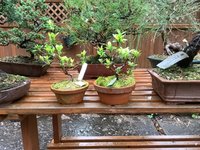Miyama Mangetsu
Seed
Hello everyone,
I’m a Bonsai beginner.
I received this Azalea as a gift last Christmas. It was bought online and the only information I could get from the vendor is the name, it supposed to be a “Azalee Satsuki Miyama Mangetsu”. I kept it in an protected corner in the balkony and the winter wasn’t that harsh but the bonsai completely turned brown (The picture is from a few minutes ago) is that normal over the winter? Maybe I should have watered it more often even when it was cold outside?
I googled the name Miyama Mangetsu and didn’t find any information about it, I guess it needs the same care as a common Azalea? If not, what’s the proper care?
Thank!
I’m a Bonsai beginner.
I received this Azalea as a gift last Christmas. It was bought online and the only information I could get from the vendor is the name, it supposed to be a “Azalee Satsuki Miyama Mangetsu”. I kept it in an protected corner in the balkony and the winter wasn’t that harsh but the bonsai completely turned brown (The picture is from a few minutes ago) is that normal over the winter? Maybe I should have watered it more often even when it was cold outside?
I googled the name Miyama Mangetsu and didn’t find any information about it, I guess it needs the same care as a common Azalea? If not, what’s the proper care?
Thank!











